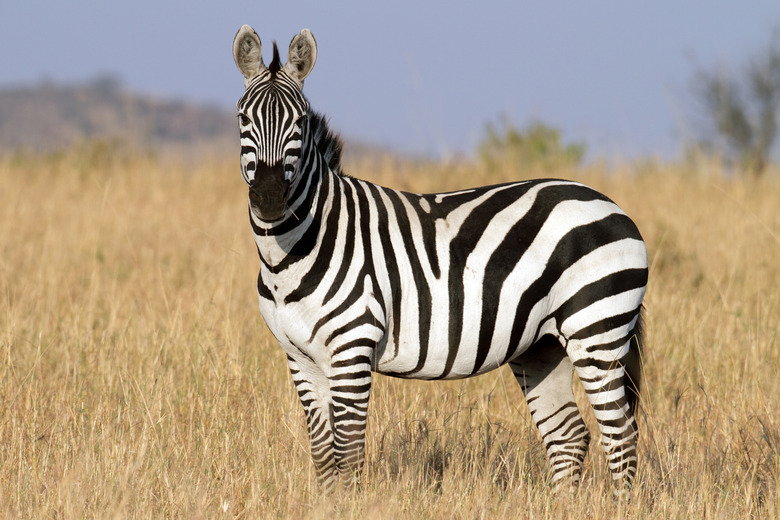Characteristics Of A Zebra
The zebra's classic black and white stripes have infiltrated fashion and home décor alike, but their immediately recognizable coloration is just one of many unique zebra characteristics. There are three different species of zebras, and each have their own individual characteristics as well. Despite their seemingly similar appearance, each species has its own unique zebra traits.
Zebra Classification
Zebra Classification
Scientists classify all three zebra species in the genus Equus. Members of the Equus genus, colloquially known as equines, include eight total species of horses, donkeys and zebras. As part of the taxonomic order Perissodactyla, the closest relatives to the equines are rhinoceroses and tapirs.
Researchers recognize three different zebra species: the mountain zebra (Equus zebra), the plains zebra (Equus quagga), and Grevy's zebra (Equus grevyi).
Zebra Characteristics
Zebra Characteristics
With a few genetically unique exceptions, all zebra species typically have white coats with black or brown stripes. All zebra species also feed primarily on grasses, though they occasionally browse on leaves and shrubs. However, each zebra species also has some unique characteristics.
Mountain zebra characteristics:
- Vertical stripe pattern along neck and back, gradually becoming horizontal at their hind legs.
- Dewlap (a fold of skin) on their throat which is similar to an Adam's apple in humans.
- Hard, pointed hooves that help their impressive climbing ability.
Plains zebra characteristics:
- Stripes that meet and connect underneath their bellies.
- Smallest zebra species, standing just 3.6 to 4.7 feet tall at the shoulder.
- Some subspecies have light brown "shadow" stripes between their primary stripes.
Grevy's zebra characteristics:
- Largest zebra species, weighing up to 990 pounds and standing up to five feet tall at the shoulder.
- Thicker neck than other species, giving them an almost mule-like appearance.
- Large, noticeably rounded ears.
- Thin, closely packed stripes.
Zebra Behavior
Zebra Behavior
The makeup and behavior of a group of zebras, also known as a herd, varies based on the species. Though all zebras have social tendencies, different species congregate in larger or more concrete herds than others.
Grevy's zebras have the most flexible social structure, and herds can change members daily. Conversely, plains zebras form strong bonds within their herds, and females often remain together for long periods even if their stallion perishes.
Regardless of species, in all breeding herds a stallion (male zebra) protects and mates with a number of mares (female zebras). The group of female zebras "held" by a stallion is known as a harem. The stallion guards his harem from predators and from other stallions.
Zebra Conservation Status
Zebra Conservation Status
All three zebra species have some level of population threat. The species with the largest population is the plains zebra, with up to 250,000 wild individuals across their range. However, their populations are declining, and the International Union for Conservation of Nature lists the plains zebra as "near threatened." Hunting is the primary threat to this species and the practice has even driven an entire subspecies, the quagga, to extinction.
The IUCN lists the mountain zebra as "vulnerable" but reports that their population is increasing. Researchers estimate wild populations at nearly 35,000 individuals as of 2019. Different subspecies within this population face different primary threats. Some of the factors impacting these zebras include drought, inbreeding, hunting and direct persecution by farmers as competition for grazing land.
Finally, the IUCN lists the Grevy's zebra as "endangered" and reports their current population as stable. Current estimates place their populations at about 2,000 wild individuals. The gravest threat to this species is habitat destruction and depletion of available food sources by livestock. Hunting and disease also poses a direct threat to the survival of this species.
Cite This Article
MLA
Zinni, Yasmin. "Characteristics Of A Zebra" sciencing.com, https://www.sciencing.com/characteristics-zebra-8001369/. 30 September 2021.
APA
Zinni, Yasmin. (2021, September 30). Characteristics Of A Zebra. sciencing.com. Retrieved from https://www.sciencing.com/characteristics-zebra-8001369/
Chicago
Zinni, Yasmin. Characteristics Of A Zebra last modified March 24, 2022. https://www.sciencing.com/characteristics-zebra-8001369/
